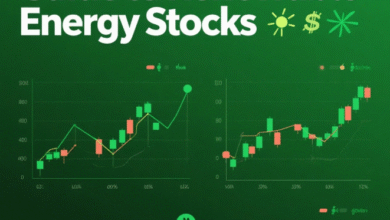Economic Indicators Analysis: How to Decode Key Signals for Smarter Financial Decisions
Advertisement
Every time I check the news, I notice talk about the economy, whether it’s booming or slowing down. But behind those headlines, there’s a world of numbers and reports that shape our understanding of what’s happening. That’s where economic indicators come in, and they’re more important than most people realize.
I’ve learned that analyzing these indicators isn’t just for economists or investors; it’s also beneficial for individuals who want to make informed decisions. Anyone can use them to get a clearer picture of where things might be headed. By paying attention to the right signals, I can make more informed decisions, whether I’m considering job investments or big purchases. Let’s delve into what these indicators mean and why they are so significant.
Understanding Economic Indicators
Economic indicators serve as quantitative tools for measuring financial performance and forecasting future conditions. I rely on indicators such as GDP, unemployment rates, inflation figures, and consumer confidence indexes to gauge the economic health. GDP represents the total value of goods and services produced. Unemployment rates track the portion of jobless individuals seeking work. Inflation measures price changes, and consumer confidence reflects household outlooks on spending. Each indicator provides context to trends influencing markets and policies.
I categorize economic indicators into three types: leading, lagging, and coincident. Leading indicators such as new housing starts and stock market returns signal potential trends before shifts occur. Lagging indicators, such as the average duration of unemployment and corporate profits, confirm patterns following economic changes. Coincident indicators, such as industrial production and personal income, monitor real-time activity, aligning with overall economic movement.
Policymakers, analysts, and business owners analyze combinations of these indicators for comprehensive economic analysis. For example, when consumer confidence increases as inflation slows, spending usually rises, and business investment follows. I compare data across indicators to validate trends and spot discrepancies that warrant further investigation.
| Indicator Type | Examples | Economic Context |
|---|---|---|
| Leading | New housing starts, stock market returns | Predict future trends |
| Lagging | Corporate profits, unemployment duration | Confirm trends after changes |
| Coincident | Industrial production, personal income | Monitor current economic activity |
Types of Economic Indicators
Economic indicators are categorized into three types: leading, lagging, and coincident, with each group measuring distinct stages of economic activity. I use these categories to refine my analysis and distinguish short-term signals from long-term movements.
Leading Indicators
Leading indicators signal changes before broader economic trends emerge. I rely on examples like stock market performance, new housing starts, building permits, and manufacturers’ new orders for goods. These signals often forecast shifts, with readings such as the Conference Board Leading Economic Index offering composite snapshots for predictive purposes.
Lagging Indicators
Lagging indicators confirm patterns that have already occurred after broader trends have taken place. I monitor key indicators such as unemployment rates, corporate profits, the consumer price index (CPI), and labor costs per unit of output. Since these figures shift only after economic events have unfolded, they confirm the turning points observed in previous cycles.
Coincident Indicators
Coincident indicators reflect current economic activity as it occurs. I use examples such as industrial production, personal income, nonfarm payrolls, and retail sales when tracking current economic conditions. These metrics align directly with fluctuations in GDP, offering immediate context for real-time policy and business decisions.
Key Economic Indicators to Monitor
Key economic indicators provide quantitative evidence that informs my interpretation of the economy’s direction. I focus on distinct metrics to uncover real trends behind market headlines.
Gross Domestic Product (GDP)
Gross Domestic Product (GDP) quantifies the total value of goods and services produced within a specific period. I reference quarterly and annual GDP figures as benchmarks for national economic growth. For example, a rise in GDP signals expansion, while negative growth rates indicate contraction. The U.S. Bureau of Economic Analysis releases GDP data, with quarterly changes often setting the tone for policy and investment responses.
Unemployment Rate
The unemployment rate measures the proportion of individuals in the labor force unable to find work. I track monthly updates from the U.S. Bureau of Labor Statistics, using these rates to assess workforce utilization and economic health. A low unemployment rate, such as 3.8% in May 2024, typically reflects an active job market. Persistent high unemployment often coincides with recessions or structural economic challenges.
Inflation Rate
The inflation rate captures changes in the overall price levels of goods and services. I monitor metrics like the Consumer Price Index (CPI) and Personal Consumption Expenditures (PCE) for monthly and annual inflation data. For instance, the CPI registered a 3.3% increase year-over-year in April 2024, according to the U.S. Bureau of Labor Statistics. Moderate inflation aligns with economic stability, while sharp increases or deflation can disrupt consumer purchasing power and business costs.
Consumer Confidence Index
Consumer Confidence Index reflects consumers’ attitudes about economic conditions and their willingness to spend. I analyze monthly reports from organizations like The Conference Board, which aggregates survey responses to generate an index value. For example, an index level above 100 signals optimistic sentiment, while a dip below indicates caution or concern. Shifts in consumer confidence often precede changes in spending patterns and retail activity.
Methods of Economic Indicators Analysis
I utilize analytical frameworks to interpret economic indicators, employing a combination of quantitative and qualitative approaches. This section explains methods for gaining deeper insights into economic indicators.
Quantitative Analysis Techniques
I apply quantitative analysis techniques to measure economic indicators with numerical precision and accuracy. I use statistical models to compare current data against historical trends, identifying cyclical patterns and structural shifts. Regression analysis helps me isolate relationships, such as the correlation between inflation and unemployment. I rely on time series analysis when tracking variables like GDP, CPI, and industrial output over multiple periods. Index construction converts raw data into composite metrics, such as the Producer Price Index or the Leading Economic Index. I use visualization tools, including line graphs and scatter plots, to highlight trends and outliers among key indicators.
Qualitative Assessment Approaches
I employ qualitative assessment approaches by evaluating the narrative context surrounding economic indicators. I review expert commentaries, central bank statements, and fiscal policy updates for shifts in economic sentiment. I analyze business surveys and consumer interviews, such as those captured in the Beige Book, to gauge confidence and market expectations. I assess geopolitical events, trade dynamics, and regulatory changes for potential impacts on reported quantitative data. I synthesize news coverage, company reports, and industry-specific information to clarify anomalies or confirm quantitative findings.
Applications of Economic Indicators Analysis
Economic indicators analysis drives real-world decisions across sectors. I apply these insights to investment strategy and public policy formulation, creating actionable guidance for varied audiences.
Guiding Investment Decisions
I use economic indicators analysis to inform investment decisions. Performance metrics, such as GDP growth rates, inflation levels, and employment data, help me assess economic cycles and allocate assets effectively. For example, if leading indicators show accelerating consumer spending or industrial production, I might shift funds toward equities or growth assets. During periods of rising unemployment claims or contracting manufacturing indexes, I consider defensive stocks or fixed-income securities as a prudent investment strategy. Asset managers and retail investors track patterns in economic data to identify entry and exit points, reacting quickly to confirmed macroeconomic shifts.
Shaping Government Policy
I rely on economic indicators analysis to shape government policy responses. Central banks reference inflation indices, labor market statistics, and GDP trends when adjusting interest rates. For instance, persistent inflation above target levels prompts central banks, such as the US Federal Reserve, to increase policy rates. Governments use unemployment data and retail sales metrics to determine if fiscal stimulus or support measures are warranted. Policy analysts synthesize coincident and lagging indicators, such as wage growth and commercial production figures, to recommend measures ensuring stable development, employment, and price stability.
Challenges in Economic Indicators Analysis
Accuracy in economic indicators analysis is hindered by issues arising from data revisions and inconsistent data quality. Agencies like the US Bureau of Economic Analysis update initial GDP figures multiple times, adding uncertainty to early decisions. Unemployment figures, for example, can shift significantly after resampling or reclassification.
The timeliness of economic indicator releases affects decision-making effectiveness. Delays in reporting metrics, such as the consumer price index or industrial production, sometimes leave policymakers and analysts working with outdated information.
Interpretation of mixed signals from multiple indicators complicates analysis. Leading, lagging, and coincident indicators often point in different directions, as in 2020, when consumer confidence diverged from retail sales trends. Discrepancies like these require context-driven judgment and verification from supplementary data.
Globalization adds complexity as interconnected economies, such as the US, China, and Germany, transmit shocks more quickly. Analysts tracking trade balances must factor in exchange rate fluctuations and foreign policy shifts; otherwise, they risk misreading domestic numbers.
Adjustment for seasonality or one-time events can distort economic indicator readings. Holidays or natural disasters, for example, can cause sudden spikes or drops in retail sales or employment data, complicating longer-term assessments.
Differences in data collection, definitions, and methodologies limit the comparability of data across economies. Definitions of unemployment and inflation vary by country, so cross-border analysis needs careful normalization.
Policy changes, tax reforms, and external shocks inject volatility into economic time series, affecting the reliability of regression analysis or forecasting models. Rate hikes by the Federal Reserve can lead to rapid adjustments in financial markets, rendering model-based interpretations built on historical patterns less reliable.
- Data accuracy: Revisions to GDP and labor statistics affect reliability.
- Timeliness: Reporting lags for inflation and production figures delay decisions.
- Mixed signals: Divergent trends in consumer confidence and retail sales require deeper review.
- Global complexity: International trade dynamics and currency shifts alter domestic readings.
- Seasonal effects: Holidays and weather disruptions create misleading data spikes.
- Cross-country comparability: Methodological differences hinder international assessments.
- Policy and external shocks: Sudden legislative or market changes disrupt model consistency.
Conclusion
Analyzing economic indicators has become a vital part of my approach to understanding the ever-changing financial landscape. By staying attentive to both quantitative data and the stories behind the numbers, I can make more informed decisions in my personal and professional life.
The ability to interpret these signals gives me an edge, whether I am evaluating investment opportunities or anticipating shifts in the job market. With the right tools and a critical mindset, I am better equipped to respond to economic changes and capitalize on emerging opportunities.
Frequently Asked Questions
What are economic indicators?
Economic indicators are measurable statistics, such as GDP, unemployment rates, and inflation, that provide insight into the health and direction of the economy.
Why should non-experts pay attention to economic indicators?
Everyone can benefit from understanding economic indicators, as they help inform decisions about jobs, investments, and major purchases by revealing trends in the economy.
What are the main types of economic indicators?
There are three main types: leading indicators (predict future trends), lagging indicators (confirm trends after changes have occurred), and coincident indicators (show current economic activity).
Which economic indicators are most important to watch?
Key indicators include Gross Domestic Product (GDP), unemployment rate, inflation (often measured by Consumer Price Index), and the Consumer Confidence Index.
How do leading and lagging indicators differ?
Leading indicators forecast future economic activity, while lagging indicators only change after the economy has already begun to follow a certain trend.
How is GDP used in economic analysis?
GDP measures the total value of goods and services produced in a country, indicating whether the economy is growing or contracting.
Why does the unemployment rate matter?
The unemployment rate indicates the number of people actively seeking employment, reflecting the overall health of the job market and the economy.
How does inflation impact the economy?
Inflation measures the rise in prices. Moderate inflation is normal, but sudden spikes can erode purchasing power and destabilize the economy.
What does the Consumer Confidence Index tell us?
It measures how optimistic or pessimistic consumers are about the economy, often predicting trends in consumer spending and retail sales.
How are economic indicators analyzed?
Experts utilize both quantitative methods (such as statistical models and graphs) and qualitative insights (like expert commentary) to interpret data.
What challenges exist when analyzing economic indicators?
Data revisions, reporting delays, inconsistent quality, mixed signals, and global interconnections can complicate the analysis and interpretation of economic indicators.
How do economic indicators influence investments?
Investors utilize indicators to assess economic trends and adjust their portfolios, favoring different asset classes in response to changing economic conditions.
In what ways do economic indicators affect government policy?
Governments and central banks use indicators to inform policy decisions on interest rates, employment programs, and economic stimulus measures, thereby maintaining stability.
Can economic indicators be compared across countries?
Comparisons can be difficult due to differences in data collection methods, definitions, and economic structures between countries.
How often are economic indicators updated?
Most indicators are updated monthly or quarterly, although the frequency varies depending on the specific measurement and data source.










